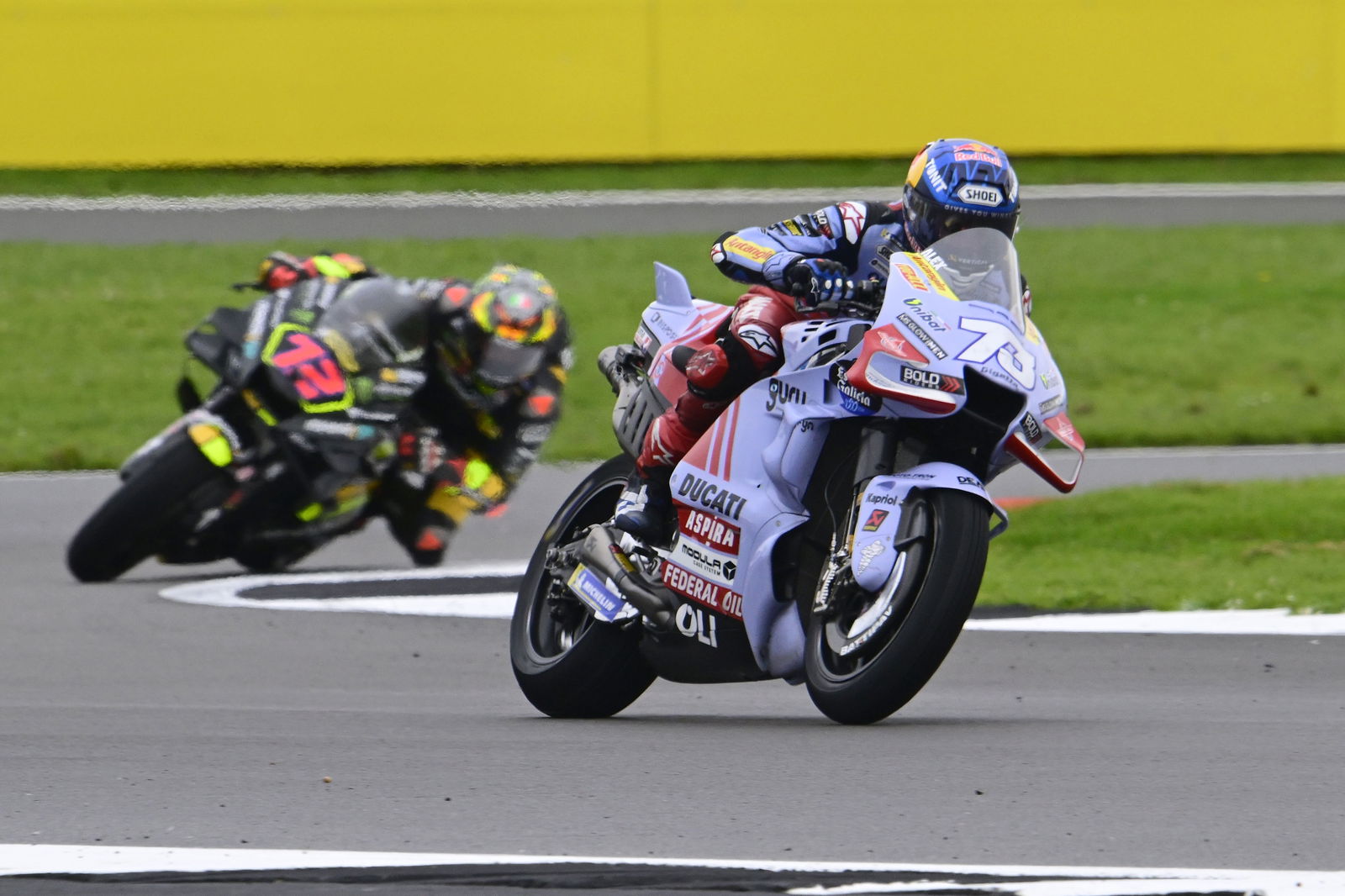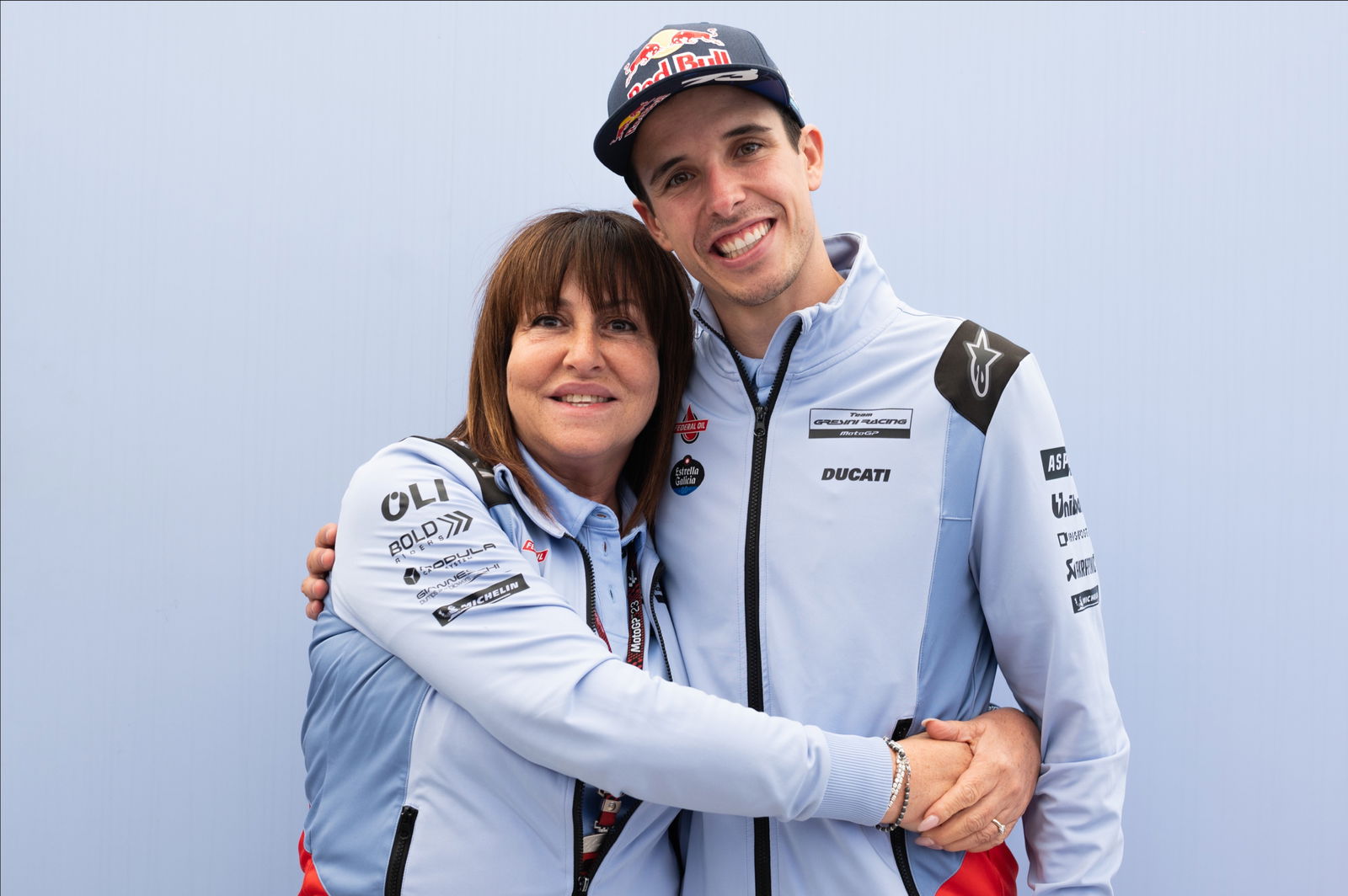MotoGP Silverstone, Sunday: Tyres, grip, and changeable conditions
The MotoGP British Grand Prix had been a race complicated by rain and low grip, and the effect the latter had on tyre choice, wear, and management.

The reality of racing is that nothing is stable, nothing stays the same. Similarly, weather conditions in Britain in the summer have the habit of changing, and that was the case on Sunday in Silverstone for the MotoGP British Grand Prix.
In fact, that was true of the whole weekend. Friday was dry, Saturday was very wet, and Sunday was dry until it was slightly-less-dry in the second half of the MotoGP race.
The changeable conditions through the weekend, particularly the change from a wet Saturday to a dry Sunday - with the crucial exception of Warm-Up - meant riders had to adapt themselves back to their references, markers and style of Friday- when it was last dry before the Grand Prix - in a race scenario. Fabio Di Giannantonio explained why this is difficult, but not as difficult as it may seem.
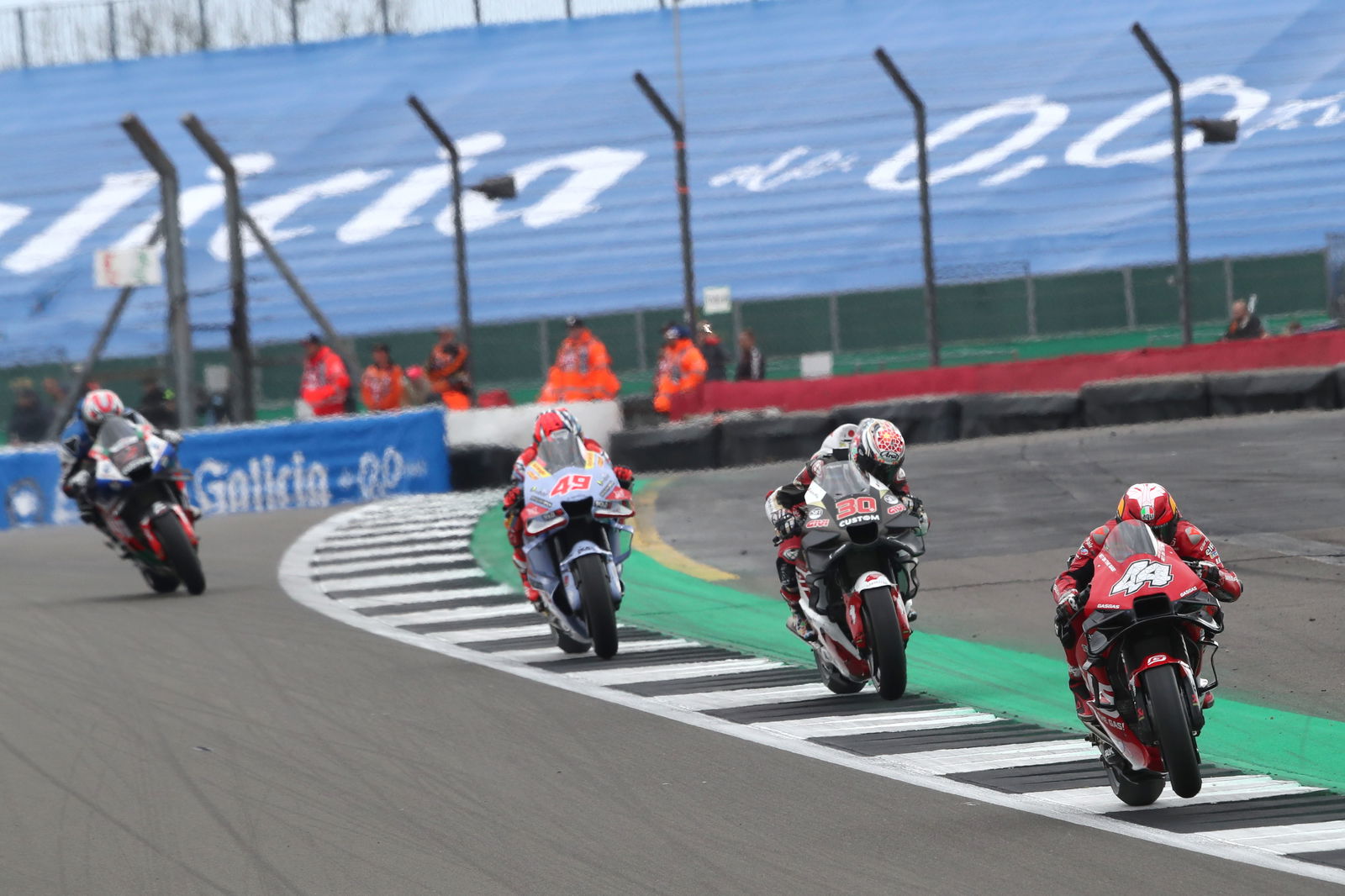
“Yes, it is hard but also we have a great group of engineers and staff that give you a baseline, a guideline, of how to ride in the race track,” Di Giannantonio said. “In the end, for us it’s quite easy to be back in the marks that we follow in the track - where to brake, where to open the throttle, and these things - to adapt the riding style to go faster in the dry. So, it’s difficult, but it’s not so difficult.”
The challenge of the Sunday conditions alone were enough to catch out a number of riders, including LCR Honda fill-in Iker Lecuona. “I feel good on the bike in dry conditions,” Lecuona said, but when the rain started “it [was] a little bit of a gamble, whether [to] stop or not.”
Lecuona said that, perhaps understandably considering his lack of recent MotoGP experience compared to those he was sharing the track with, “honestly I stopped just because Taka [Nakagami] stopped and a few riders in front stopped. I didn’t have time to think, I go in[to the pits to change bikes] and I say ‘why did I [come] in?’
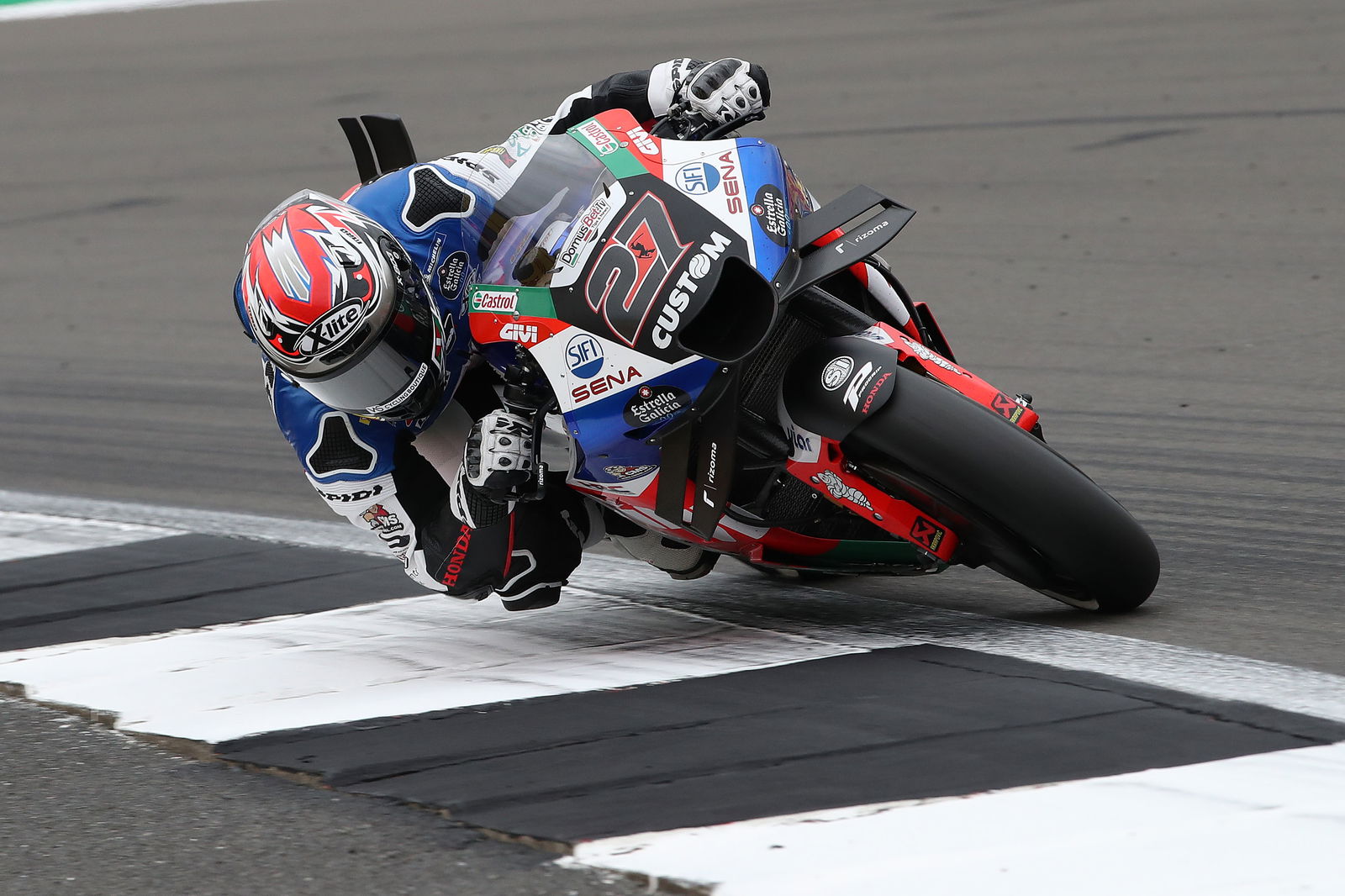
“Honestly, I think I’m stupid to stop, because it’s just a few corners [that were wet], but it’s what it is, it’s racing, so then when I [pitted] I thought ‘okay, I just need to stay on the bike and finish race.’ I [couldn’t] do anything because the track was dry and I [had] the soft wet tyre in the rear.
“On the second lap, I destroyed the tyre,” Lecuona continued. “It was [only] five laps in the wet, so the last three laps I [went] really, really slow.”
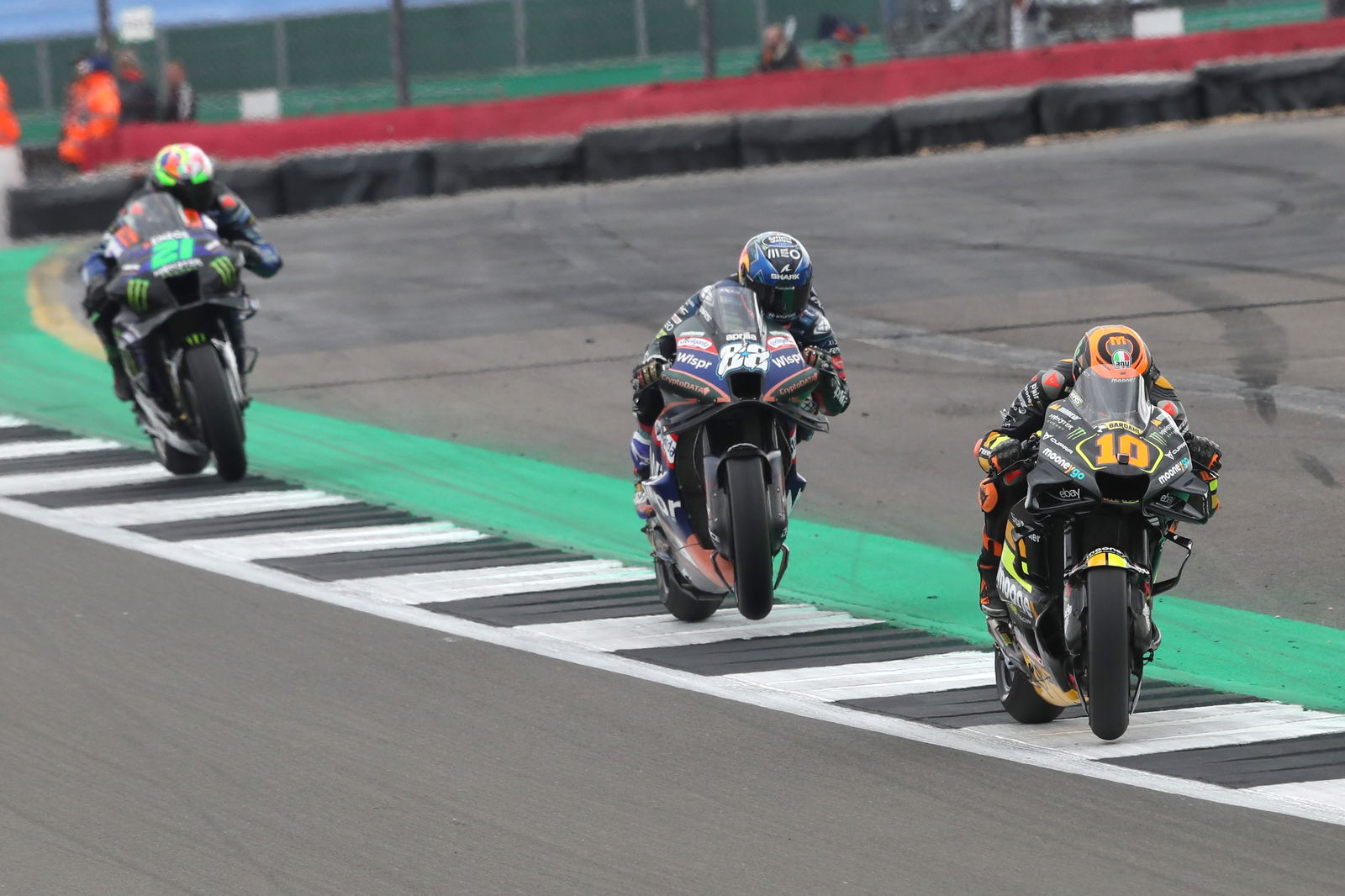
Luca Marini’s race had started badly. He had lost positions on the start, and was making his way forwards when the rain arrived. As the track was rubbering in, “the feeling [was] starting to get better,” Marini said. At this point, he continued, “I was trying to improve my lap time, but then it started to rain a little bit.
“Then, I start to lose a lot of time fighting with the other riders, and [at that point] the race was finished.”
Jack Miller had an opposite view of the rain to Marini. Instead of killing his race, for Miller the rain revived it after contact with Maverick Vinales had sent him straight on at Copse. “We got lucky with the rain,” Miller said. “I was able to take a little bit more risk than the others, I had plenty of bikes in front of me and could see how the grip was. So, I was able to take a little bit more risk in the places where it was raining, and was able to make up a few spots.”
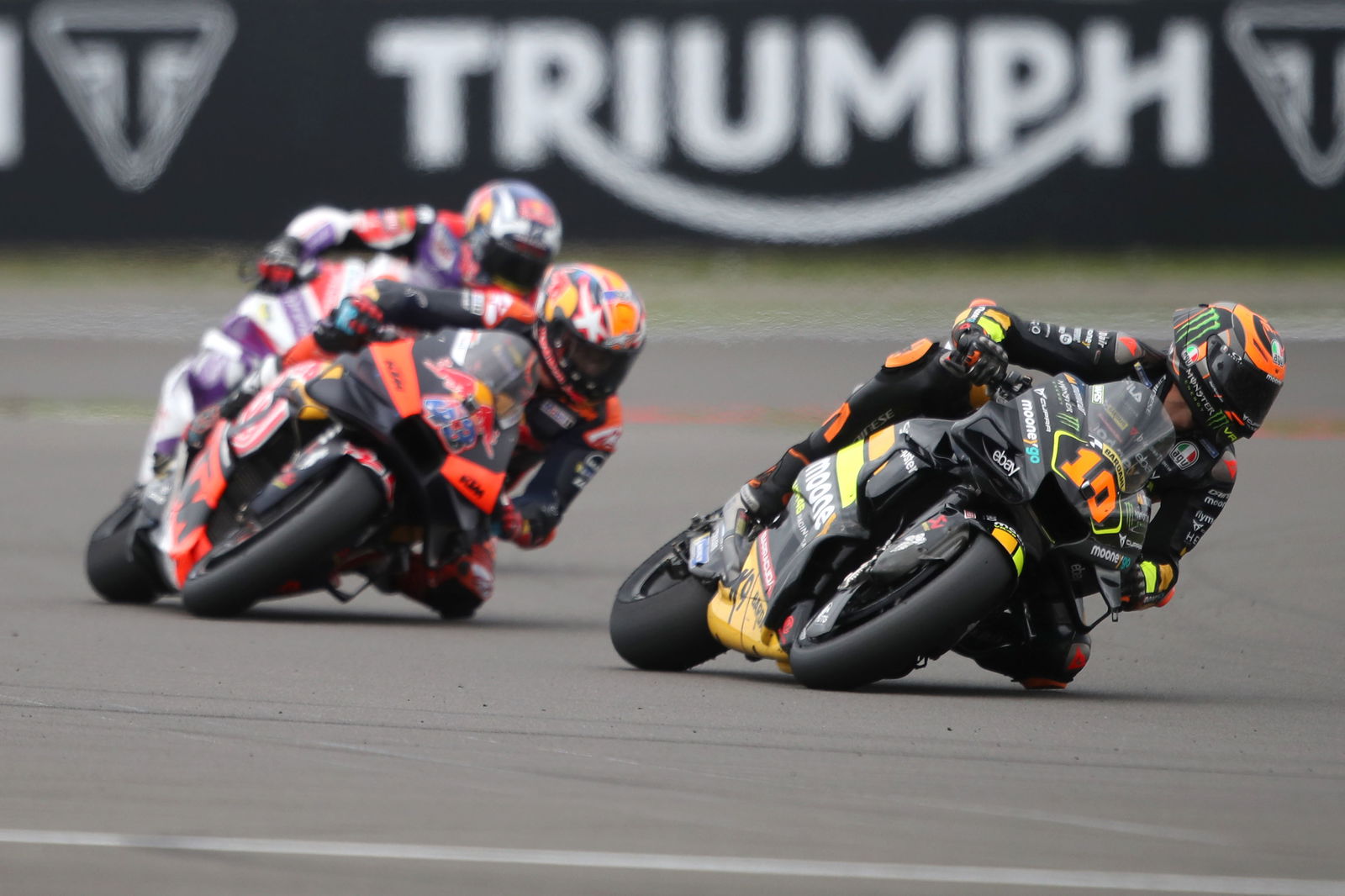
Miller was one of the riders behind Marini, who concurred with Miller’s view that the reference riders ahead were of benefit.
Unlike Miller, Marini had no riders close in front of him, so he was trying to take minimal risks as the conditions were changing, because he could not decipher from the riding of others how much grip the track was offering.
“Miguel [Oliveira], in front of me, was far away,” Marini explained, “so I was quite alone and I [could] not see if [the track] was wet or not. I was trying to understand, but trying to be careful, also. The riders behind me overtook me in that moment.”
Miguel Oliveira spent the second half of the race, when the rain had started to fall, closing in on the leaders. He somewhat supported Marini’s regarding having riders ahead to reference in changeable conditions, having had a similar experience to Miller.
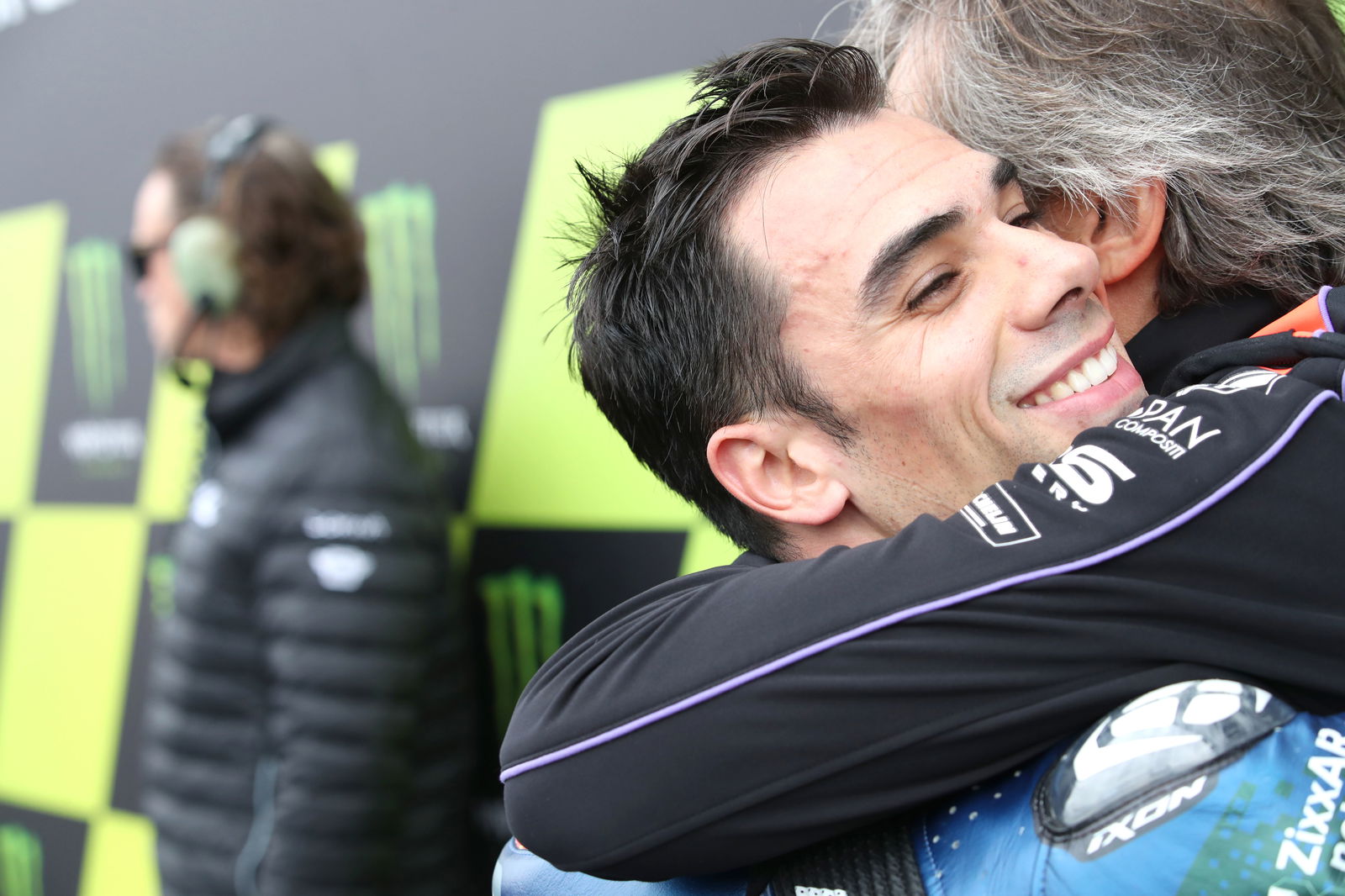
“For sure,” Oliveira said, “the rain helped me to catch [the leaders] because I just took more risks, and I was lucky not to crash. That was it.”
Was it easier for Oliveira because he had the references - of Brad Binder, Maverick Vinales, Aleix Espargaro, and Francesco Bagnaia - ahead of him? “Yeah, exactly, that’s what my father said to me: ‘It’s easy because you see the guys and if they crash and have any moments then you can slow down!’ It’s like, yeah, it’s not the same, but I know what you mean. Yeah, you have the target, and if they are a little bit too careful you [...] go a bit faster and see what happens.”
Johann Zarco explained the competitive difficulty of the conditions. When the rain arrived, “I wanted to have a bit of advantage,” Zarco said. However, “we are all thinking the same, and we don’t want to crash.” Essentially, every rider thinks the conditions can play to their advantage, so they all push to the limit and effectively cancel each other out.
Tyres, as ever, also played their role. Choice of compound, and how that compound was managed through the 20 laps, were critical components in making a result either good or bad.
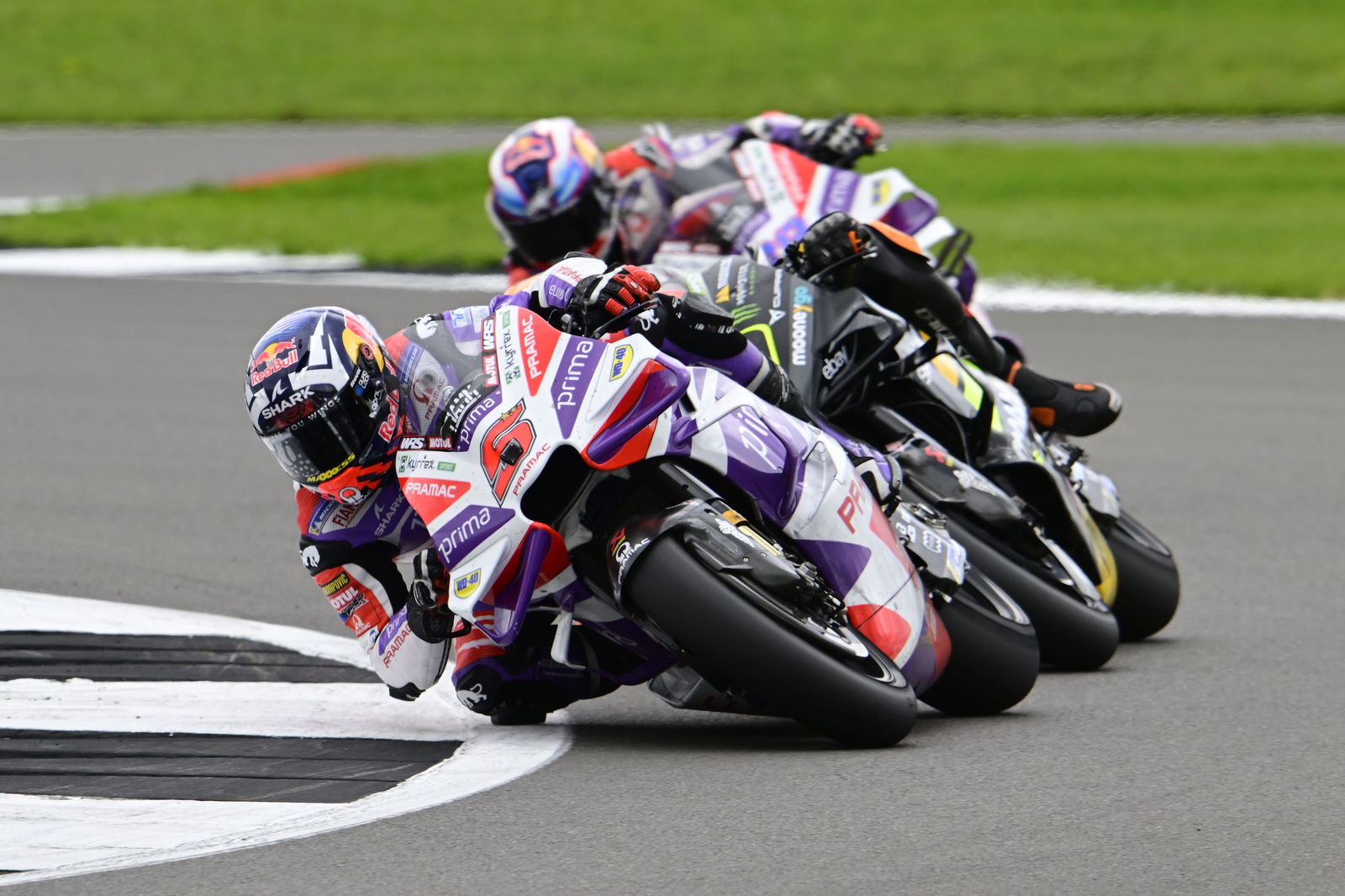
Zarco felt he had problems at both ends, but that that at the front was of more consequence to his result. “I chose to go on the soft rear tyre,” Zarco said, “because it was quite cold and I knew that I could not use the medium rear well.
“So, I wanted to feel good from the beginning, thinking then that I can handle my rear tyre [consumption]. And I think the rear tyre has been a problem for the last five laps, or the last four laps.”
Zarco had tried the medium compound rear tyre on Friday, but felt the ambient and track temperatures were too cold to risk that tyre with its longer warm-up period compared to the soft. “We were scared to have these five laps to make [the medium rear tyre] work well,” Zarco said. “I’m not using the tyres [like] the others, so [there] would have been even more problems for me to really start the race well.” So, Zarco’s choice of the soft rear tyre was a bet on his tyre management abilities, which in the end went against him as the tyre wore too much in the final five laps.
But, at the front, the problem was more significant. “The main problem has been at half-race, when I was still with Brad [Binder] and [Maverick] Vinales, [when] I [overheated] the front [tyre] and I had a few [...] very scary moments, and I lost a lot of time.
“Then, I tried to bring down the temperature in the front. I was slowing down, but the front temperature was not going down. I lost so much time, and I could not fight with the riders that were overtaking me.”
When Zarco was asked whether his front tyre temperature problems were related to the new front tyre pressure rules introduced from this weekend - which will penalise a rider for being below the minimum tyre pressure for too many laps in the race - the Pramac Ducati rider was absolute. “For sure,” he said.
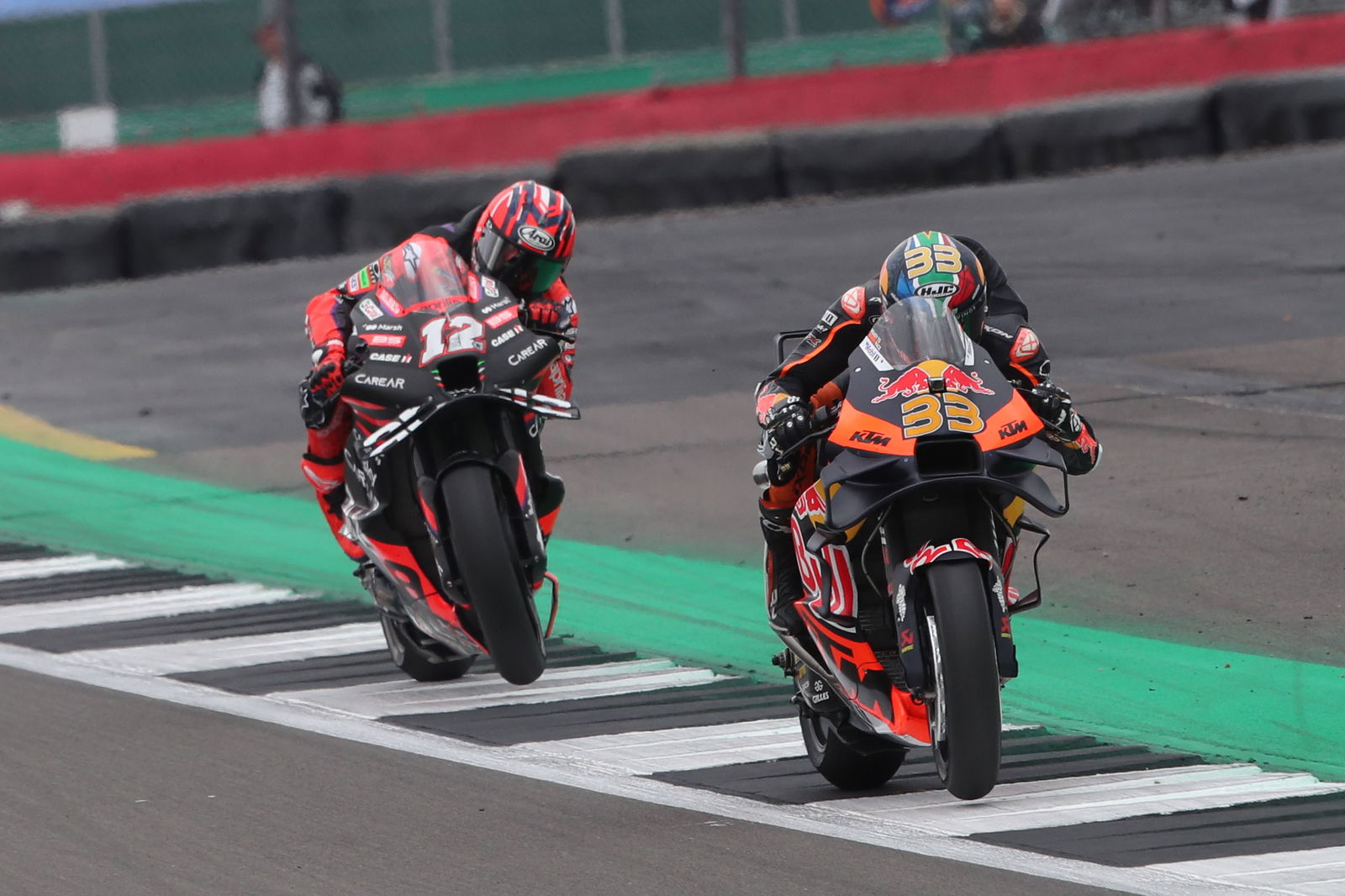
Maverick Vinales said the low temperatures at Silverstone were fortunate with the new rules. “I think honestly in this weekend we were lucky that it was cold,” Vinales said. “Let’s see [what happens] in Austria, that is hard braking.”
Luca Marini struggled with traction throughout the race. “I expected, sincerely, a different weekend,” Marini said. “But, anyway, we have something to understand, to analyse, why my feeling is like this, and I’m losing so much in acceleration when there is no grip on-track.”
The issue prevented Marini from being able to pass. This cost him a lot of time with Johann Zarco. “I’m losing a lot of time in acceleration,” Marini explained. “So, it’s difficult for me to make overtakes. I tried to risk a lot in the middle of chicanes, try to do some crazy moves, because it’s the only way for me to overtake.”

In comparison, “for Johann,” Marini said, “it’s very easy to overtake me because he accelerates very well from every corner, and he’s very strong in acceleration. And, when a rider is very close to you in the straight, then it’s easy to [brake late] and pass.
“So, we need to work a little bit to find something, because in Austria acceleration is very important.”
VR46 Ducati rider Marini felt that rear grip was a strength for Aprilia, who finished first, fourth, and fifth, instead of the weakness it was for him. “They have very good grip, and in this special condition with no rubber on track, they are really strong - stronger than us - and they can use all of their potential.”

However, Vinales was not so convinced, at least for himself. “For me, no,” Vinales said when asked whether he felt rear grip had been a strength in the race. “Because I use much less [traction control] than them. I ride more with my hand, and as soon as I lost the grip I could not do anything else.”
Miguel Oliveira somewhat concurred. He felt the rear grip was good, but that the reason was the track, not the bike. “I would say it was okay, even yesterday in the wet it was quite good. I think it’s just the way the bike works here, from the get-go it was already quite nice.”
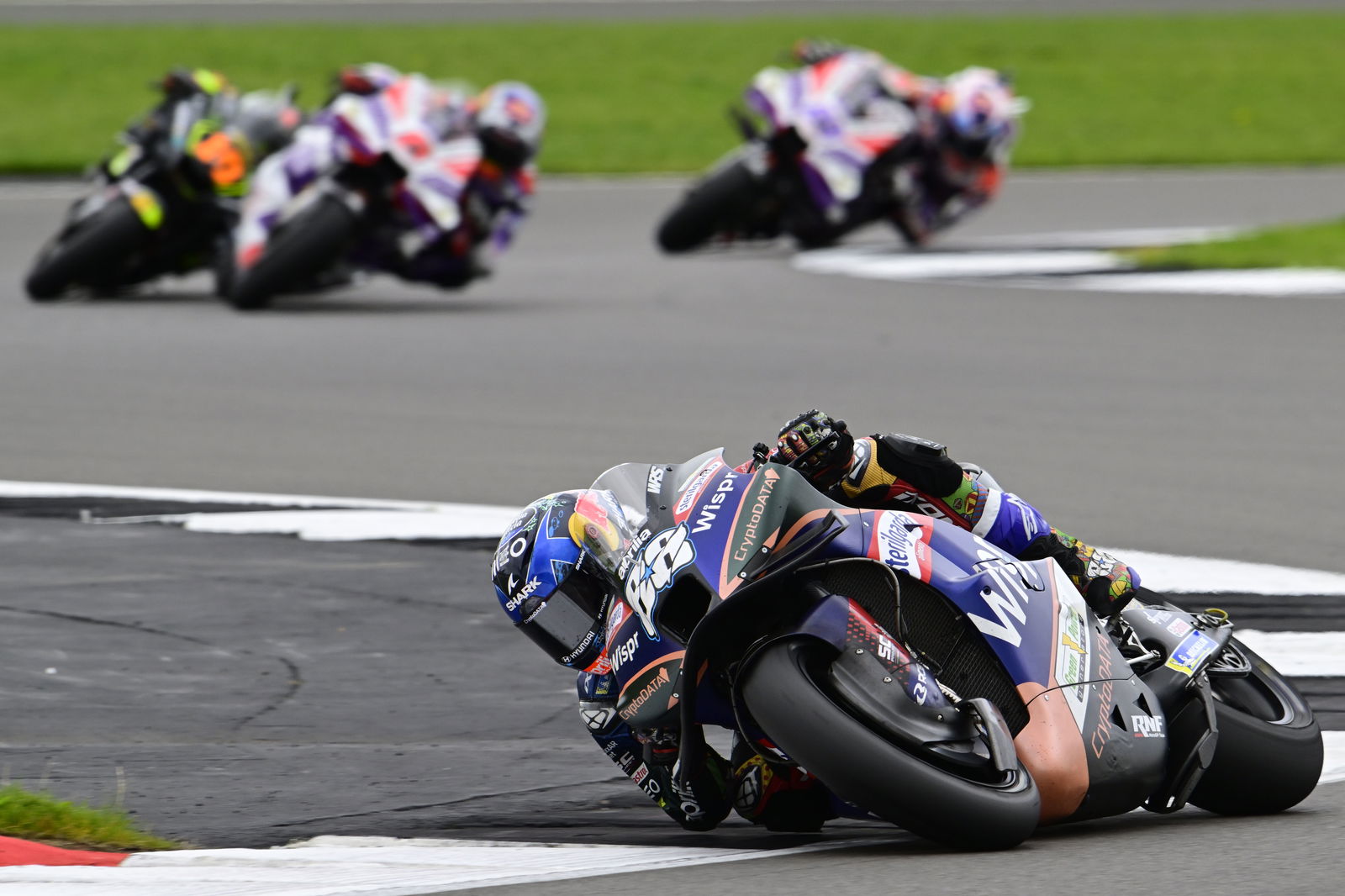
Marini’s grip issues when the track grip is low were shared by Yamaha’s Fabio Quartararo. “For me, the issue is when the track is really low grip, we are struggling so much.” Aleix Espargaro had set the best lap of the race, but in 2022 the fastest lap was over one second faster, which justified Quartararo’s theory that the grip at Silverstone this year was low, at least in the Grand Prix.
“We are losing so much in the grip [when the track grip is low], so I had no opportunity to fight with the top guys.”

Quartararo had tried a new fairing from Yamaha this weekend, with ground effect diffusers on the side, and larger, squarer top wings. Unlike the new fairings he tried in the winter, this one was a definite improvement, at least in terms of handling. Whether it provides sufficient anti-wheelie effect will only be discovered in two weeks time at the Red Bull Ring.
Quartararo’s teammate, Franco Morbidelli, had issues more similar to the #20’s compatriot, Zarco: front tyre. It was not exactly the same, though. Instead of overheating, Morbidelli’s front tyre had simply worn out.

“I had a good speed today, I was quick,” Morbidelli said. “But, at one point, I felt that I started to have major issues with the front tyre, and I completely destroyed it. I had to lose a lot of positions, and I started to drop down big time. When I saw that it was starting to drizzle, I hoped and I changed the bike [in the pits], I hoped for some more rain, but it didn’t come.”
Morbidelli had destroyed his front tyre in no more than 12 or 13 laps. “We don’t know yet,” Morbidelli replied when asked what had caused the issues with the front tyre, which bore high degradation on the right side of the tyre. “But the tyre was destroyed, I’ve never seen a tyre [like that].”
